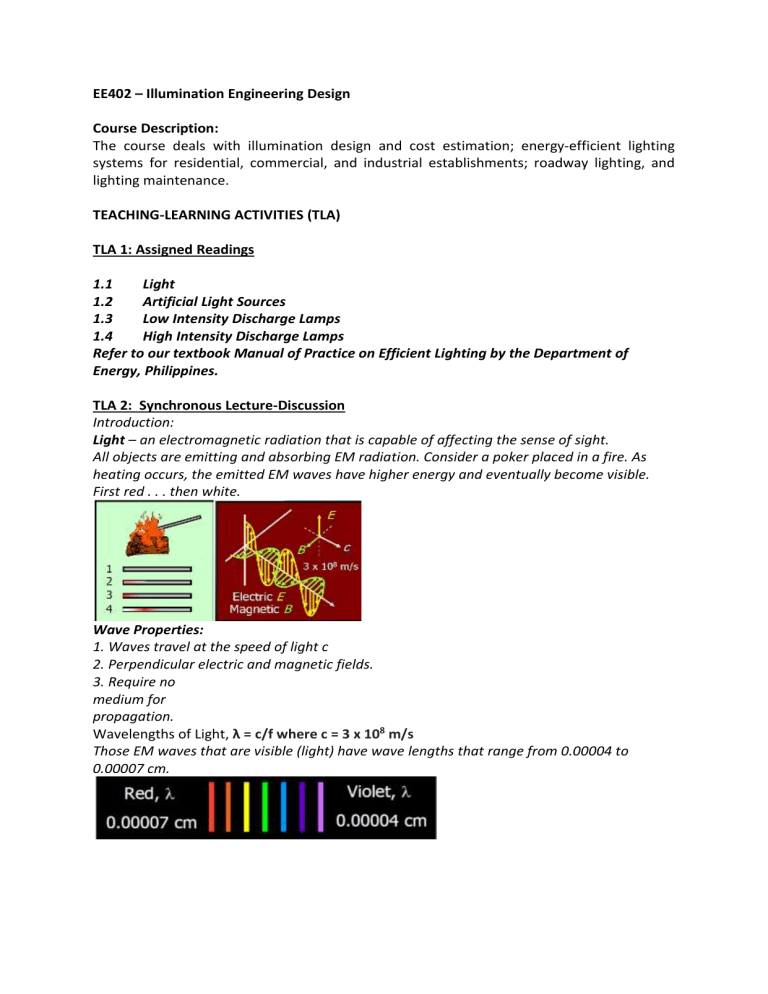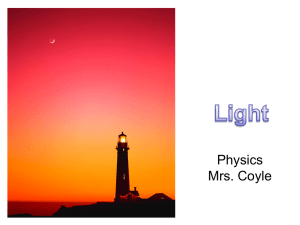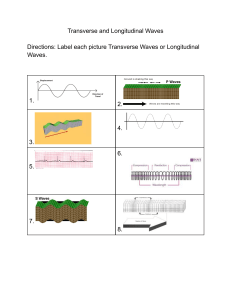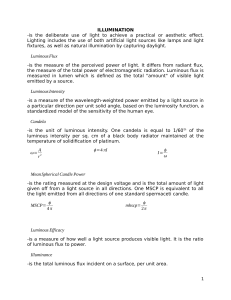
EE402 – Illumination Engineering Design Course Description: The course deals with illumination design and cost estimation; energy-efficient lighting systems for residential, commercial, and industrial establishments; roadway lighting, and lighting maintenance. TEACHING-LEARNING ACTIVITIES (TLA) TLA 1: Assigned Readings 1.1 Light 1.2 Artificial Light Sources 1.3 Low Intensity Discharge Lamps 1.4 High Intensity Discharge Lamps Refer to our textbook Manual of Practice on Efficient Lighting by the Department of Energy, Philippines. TLA 2: Synchronous Lecture-Discussion Introduction: Light – an electromagnetic radiation that is capable of affecting the sense of sight. All objects are emitting and absorbing EM radiation. Consider a poker placed in a fire. As heating occurs, the emitted EM waves have higher energy and eventually become visible. First red . . . then white. Wave Properties: 1. Waves travel at the speed of light c 2. Perpendicular electric and magnetic fields. 3. Require no medium for propagation. Wavelengths of Light, λ = c/f where c = 3 x 108 m/s Those EM waves that are visible (light) have wave lengths that range from 0.00004 to 0.00007 cm. Example 1. Light from a Helium Light from a Helium-Neon laser Neon laser has a wavelength of has a wavelength of 632 nm. What is the . What is the frequency of this wave? Properties of Light • Rectilinear propagation: Light travels in straight lines. • Reflection: Light striking a smooth surface turns back into the original medium. • Refraction: Light bends when entering a transparent medium. Flux Luminous Flux Luminous flux is the portion of total radiant power is the portion of total radiant power that is capable of affecting the sense of sight. that is capable of affecting the sense of sight. TLA 3: Multiple-Choice Questions 1. Light waves travel with a velocity of a. 3 x 1010 cm/s b. 3 x 1012 cm/s c. 3 x 1015 cm/s d. 3 x 1018 cm/s 2. Which of the following statement is correct? a. Light consists of electromagnetic waves b. Light consists of ultraviolet waves c. Light consists of infrared waves d. Light consists of gamma rays 3. Measure of brightness generated from each unit of measure of input power. a. luminous efficacy b. color temperature c. color rendering index d. lumen maintenance 4. Ability to bounce light off as many shades of color in the visible spectrum as possible. a. color temperature b. high intensity discharge c. color rendering index d. lumen maintenance 5. The advantage of correct illumination in working places. a. accident decreases b. work output increases c. waste of jobs decreases d. all of these




